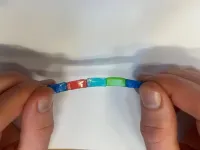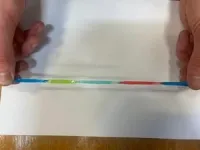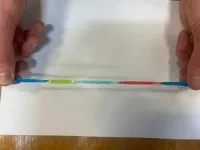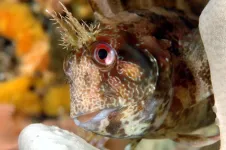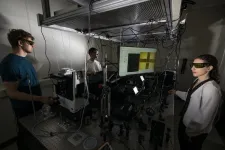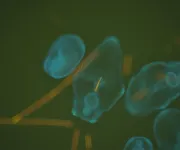(Press-News.org) Researchers have developed soft, stretchable ‘jelly batteries’ that could be used for wearable devices or soft robotics, or even implanted in the brain to deliver drugs or treat conditions such as epilepsy.
The researchers, from the University of Cambridge, took their inspiration from electric eels, which stun their prey with modified muscle cells called electrocytes.
Like electrocytes, the jelly-like materials developed by the Cambridge researchers have a layered structure, like sticky Lego, that makes them capable of delivering an electric current.
The self-healing jelly batteries can stretch to over ten times their original length without affecting their conductivity – the first time that such stretchability and conductivity has been combined in a single material. The results are reported in the journal Science Advances.
The jelly batteries are made from hydrogels: 3D networks of polymers that contain over 60% water. The polymers are held together by reversible on/off interactions that control the jelly’s mechanical properties.
The ability to precisely control mechanical properties and mimic the characteristics of human tissue makes hydrogels ideal candidates for soft robotics and bioelectronics; however, they need to be both conductive and stretchy for such applications.
“It’s difficult to design a material that is both highly stretchable and highly conductive, since those two properties are normally at odds with one another,” said first author Stephen O’Neill, from Cambridge’s Yusuf Hamied Department of Chemistry. “Typically, conductivity decreases when a material is stretched.”
“Normally, hydrogels are made of polymers that have a neutral charge, but if we charge them, they can become conductive,” said co-author Dr Jade McCune, also from the Department of Chemistry. “And by changing the salt component of each gel, we can make them sticky and squish them together in multiple layers, so we can build up a larger energy potential.”
Conventional electronics use rigid metallic materials with electrons as charge carriers, while the jelly batteries use ions to carry charge, like electric eels.
The hydrogels stick strongly to each other because of reversible bonds that can form between the different layers, using barrel-shaped molecules called cucurbiturils that are like molecular handcuffs. The strong adhesion between layers provided by the molecular handcuffs allows for the jelly batteries to be stretched, without the layers coming apart and crucially, without any loss of conductivity.
The properties of the jelly batteries make them promising for future use in biomedical implants, since they are soft and mould to human tissue. “We can customise the mechanical properties of the hydrogels so they match human tissue,” said Professor Oren Scherman, Director of the Melville Laboratory for Polymer Synthesis, who led the research in collaboration with Professor George Malliaras from the Department of Engineering. “Since they contain no rigid components such as metal, a hydrogel implant would be much less likely to be rejected by the body or cause the build-up of scar tissue.”
In addition to their softness, the hydrogels are also surprisingly tough. They can withstand being squashed without permanently losing their original shape, and can self-heal when damaged.
The researchers are planning future experiments to test the hydrogels in living organisms to assess their suitability for a range of medical applications.
The research was funded by the European Research Council and the Engineering and Physical Sciences Research Council (EPSRC), part of UK Research and Innovation (UKRI). Oren Scherman is a Fellow of Jesus College, Cambridge.
END
Soft, stretchy ‘jelly batteries’ inspired by electric eels
2024-07-17
ELSE PRESS RELEASES FROM THIS DATE:
The most endangered fish are the least studied
2024-07-17
The most threatened reef fishes are also the most overlooked by scientists and the general public. That is the startling finding of a team of scientists led by a CNRS researcher.1 In a study to be published in Science Advances on July 17, they measured the level of human interest in 2,408 species of marine reef fish and found that the attention of the scientific community is attracted by the commercial value more than the ecological value of the fishes. The public, on the other hand, is primarily influenced by the aesthetic characteristics of certain species, such as the red lionfish ...
Mindfulness training may lead to altered states of consciousness, study finds
2024-07-17
Mindfulness training may lead participants to experience disembodiment and unity – so-called altered states of consciousness – according to a new study from researchers at the University of Cambridge.
The team say that while these experiences can be very positive, that is not always the case. Mindfulness teachers and students need to be aware that they can be a side-effect of training, and students should feel empowered to share their experiences with their teacher or doctor if they have any concerns.
Mindfulness-based programmes have ...
New technique pinpoints nanoscale ‘hot spots’ in electronics to improve their longevity
2024-07-17
When electronic devices like laptops or smartphones overheat, they are fundamentally suffering from a nanoscale heat transfer problem. Pinpointing the source of that problem can be like trying to find a needle in a haystack.
“The building blocks of our modern electronics are transistors with nanoscale features, so to understand which parts of overheating, the first step is to get a detailed temperature map,” says Andrea Pickel, an assistant professor from the University of Rochester’s Department of Mechanical Engineering. “But you need something with nanoscale ...
Study shows ancient viruses fuel modern-day cancers
2024-07-17
Peek inside the human genome and, among the 20,000 or so genes that serve as building blocks of life, you’ll also find flecks of DNA left behind by viruses that infected primate ancestors tens of millions of years ago.
These ancient hitchhikers, known as endogenous retroviruses, were long considered inert or ‘junk’ DNA, defanged of any ability to do damage. New CU Boulder research published July 17 in the journal Science Advances shows that, when reawakened, they can play a critical role in helping cancer survive and thrive. The study also suggests that silencing certain endogenous retroviruses can make cancer treatments work better.
“Our study shows that diseases ...
Reef pest feasts on 'sea sawdust'
2024-07-17
Researchers have uncovered an under-the-sea phenomenon where coral-destroying crown-of-thorns starfish larvae have been feasting on blue-green algae bacteria known as ‘sea sawdust’.
The team of marine scientists from The University of Queensland and Southern Cross University found crown-of-thorns starfish (COTS) larvae grow and thrive when raised on an exclusive diet of Trichodesmium – a bacteria that often floats on the ocean’s surface in large slicks.
UQ’s Dr Benjamin Mos from the School ...
Mental health training for line managers linked to better business performance, says new study
2024-07-17
Mental health training for line managers is strongly linked to better business performance, and it could save companies millions of pounds in lost sick days every year, according to new research led by experts at the University of Nottingham.
The results of the study, which are published in PLOS ONE, showed a strong association between mental health training for line managers and improved staff recruitment and retention, better customer service, and lower levels of long-term mental health sickness absence.
The study was led by Professor Holly Blake from the School of Health Sciences at the University of Nottingham and Dr Juliet Hassard of Queen’s ...
Diatom surprise could rewrite the global carbon cycle
2024-07-17
When it comes to diatoms that live in the ocean, new research suggests that photosynthesis is not the only strategy for accumulating carbon. Instead, these single-celled plankton are also building biomass by feeding directly on organic carbon in wide swaths of the ocean. These new findings could lead researchers to reduce their estimate of how much carbon dioxide diatoms pull out of the air via photosynthesis, which in turn, could alter our understanding of the global carbon cycle, which is especially relevant given the changing climate.
This research is led by bioengineers, bioinformatics experts and other genomics researchers ...
Microbes found to destroy certain ‘forever chemicals’
2024-07-17
UC Riverside environmental engineering team has discovered specific bacterial species that can destroy certain kinds of “forever chemicals,” a step further toward low-cost treatments of contaminated drinking water sources.
The microorganisms belong to the genus Acetobacterium and they are commonly found in wastewater environments throughout the world.
Forever chemicals, also known as per- and polyfluoroalkyl substances or PFAS, are so named because they have stubbornly strong carbon-fluorine chemical bonds, which make them persistent in the environment.
The microorganisms discovered by UCR scientists and their collaborators ...
When the brain speaks, the heart feels it
2024-07-17
Research by the Technion has demonstrated that activation of the brain’s reward system could boost recovery from a heart attack. The research, which was conducted at the Ruth and Bruce Rappaport Faculty of Medicine, was led by Ph.D. student Hedva Haykin under the supervision of Prof. Asya Rolls and Prof. Lior Gepstein.
The Technion research group focused on the reward system, a brain network activated in positive emotional states and motivation and evaluated its potential in improving recovery ...
Llama nanobodies: A breakthrough in building HIV immunity
2024-07-17
ATLANTA — A research team at Georgia State University has developed tiny, potent molecules that are capable of targeting hidden strains of HIV. The source? Antibody genes from llama DNA.
The research, led by Assistant Professor of Biology Jianliang Xu, uses llama-derived nanobodies to broadly neutralize numerous strains of HIV-1, the most common form of the virus. A new study from this team has been published in the journal Advanced Science.
“This virus has evolved a way to escape our immune system. Conventional antibodies are bulky, so it’s difficult for them to find and attack the virus’ surface,” ...
